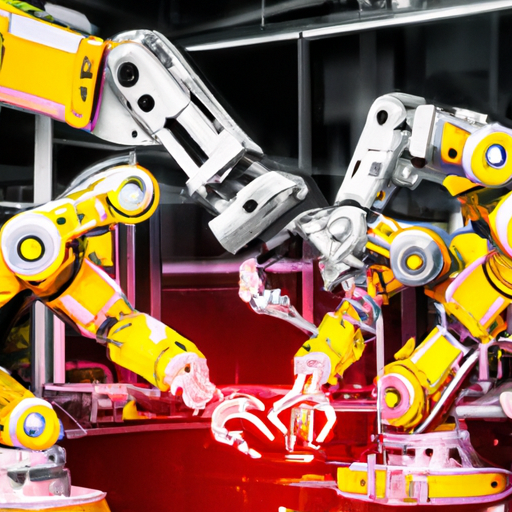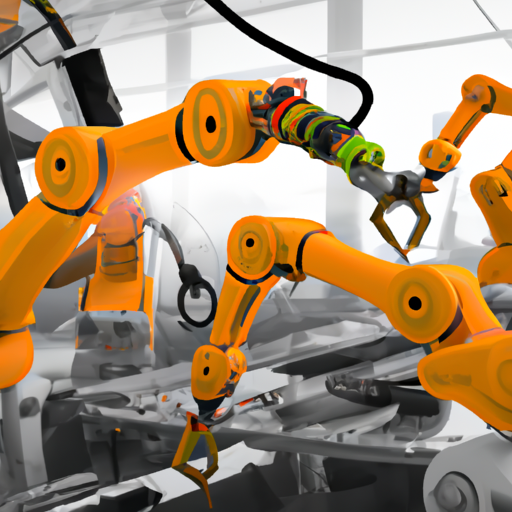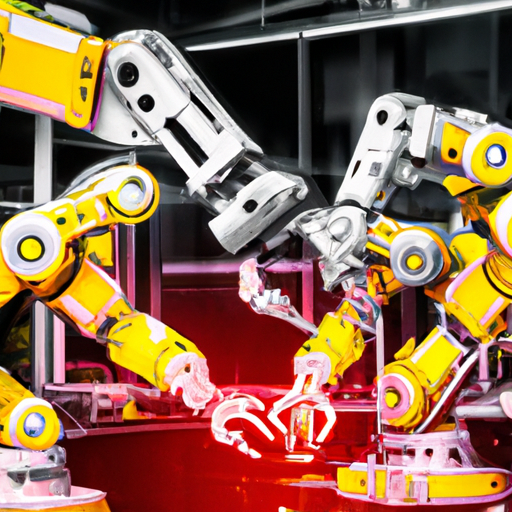Manufacturing Industry Trends
As you look at the ever-evolving landscape of the manufacturing industry, it becomes evident that trends are emerging at a staggering pace. From advancements in technology to shifts in consumer preferences, this article takes a close and captivating look at some of the most influential manufacturing industry trends. It explores how automation is revolutionizing production processes, the growing importance of sustainability, and the rise of additive manufacturing. Brace yourself for an insightful journey into the exciting and dynamic world of manufacturing.
Table of Contents
Digital Transformation
In today’s rapidly evolving world, the manufacturing industry is undergoing a significant digital transformation. Companies are embracing Industry 4.0 technologies to stay competitive and improve their operational efficiency. This digital revolution involves the integration of artificial intelligence (AI) in manufacturing processes, increased use of automation and robotics, and the Internet of Things (IoT) revolutionizing manufacturing operations.
Adoption of Industry 4.0 technologies
Industry 4.0 technologies, such as machine learning, cloud computing, and advanced analytics, are changing the landscape of the manufacturing industry. These technologies enable manufacturers to collect and analyze vast amounts of data, leading to better decision-making processes. By leveraging AI-powered technologies, companies can optimize their production processes, reduce costs, and enhance product quality.
Integration of artificial intelligence in manufacturing processes
Artificial intelligence has become a game-changer in the manufacturing industry. From predictive maintenance to quality control, AI-powered systems are being utilized to streamline operations and boost productivity. Machine learning algorithms can analyze historical data and identify patterns, helping manufacturers make data-driven decisions. AI also enables predictive and prescriptive analytics, allowing manufacturers to anticipate and address potential issues before they occur.
Increased use of automation and robotics
Automation and robotics have revolutionized the manufacturing sector. By automating repetitive tasks and improving production speed and accuracy, manufacturers can increase their overall efficiency. Robots are increasingly being used in assembly lines, material handling, and even customer service. These machines can work 24/7 without fatigue and perform complex operations with precision, ultimately reducing costs and improving productivity.
Internet of Things (IoT) revolutionizing manufacturing operations
The Internet of Things (IoT) has the potential to transform the way manufacturing operations are managed. Connected devices and sensors embedded in machines and equipment provide real-time data, allowing for remote monitoring and predictive maintenance. IoT also enables manufacturers to optimize their supply chain, track inventory levels, and enhance overall operational visibility. With IoT, manufacturers can improve product quality, reduce downtime, and gain a competitive edge.
Sustainable Manufacturing
Sustainability is a major focus in the manufacturing industry as companies strive to reduce their environmental footprint and operate in an eco-friendly manner. Sustainable manufacturing involves the shift towards eco-friendly and renewable resources, the implementation of energy-efficient practices, the reduction of waste, and the adoption of circular economy principles.
Shift towards eco-friendly and renewable resources
Manufacturers are increasingly adopting eco-friendly and renewable resources in their production processes. This includes using sustainable materials, such as biodegradable plastics or recycled materials, instead of traditional ones. By reducing the reliance on non-renewable resources, manufacturers can minimize their impact on the environment and contribute to a greener future.
Implementation of energy-efficient practices
Energy efficiency is a key component of sustainable manufacturing. Companies are investing in energy-efficient technologies and practices to reduce their overall energy consumption. This includes optimizing production processes, improving equipment efficiency, and implementing energy management systems. By minimizing energy wastage, manufacturers can lower their operational costs and reduce their carbon emissions.
Reduction of waste and carbon footprint
Manufacturers are actively working towards reducing waste generation and minimizing their carbon footprint. This involves implementing waste management practices, such as recycling and reusing materials, and adopting lean manufacturing principles to eliminate production waste. By reducing waste, manufacturers can lower costs and contribute to a more sustainable environment.
Adoption of circular economy principles
The adoption of circular economy principles is gaining momentum in the manufacturing industry. Instead of the traditional linear “take-make-dispose” model, manufacturers are transitioning towards a circular economy approach. This involves designing products for durability and recyclability, promoting the reuse of materials, and establishing closed-loop supply chains. By embracing circular economy principles, manufacturers can create economic value while minimizing resource consumption and environmental impact.

Reshoring and Localization
The concept of reshoring and localization has gained traction in recent years as manufacturers seek to bring their operations back to domestic markets. This shift is driven by the desire for shorter supply chains, reduced dependence on foreign suppliers, the implications of geopolitical events, and the opportunities provided by advanced technologies.
Return of manufacturing operations to domestic markets
Many manufacturers are reshoring their operations and bringing production back to their domestic markets. This trend is fueled by factors such as rising labor costs in offshore locations, quality control concerns, and the desire for better oversight and control over the manufacturing process. Reshoring allows companies to shorten their supply chains and gain a competitive advantage by being closer to their customers.
Desire for shorter supply chains and reduced dependence on foreign suppliers
Shorter supply chains have become a priority for manufacturers. The COVID-19 pandemic highlighted the vulnerabilities of global supply chains, prompting companies to reevaluate their dependence on foreign suppliers. By reshoring or localizing production, manufacturers can reduce lead times, mitigate risks, and respond more effectively to market fluctuations.
Implications of geopolitical events on reshoring decisions
Geopolitical events, such as trade disputes or political instability, can significantly impact manufacturing operations. Manufacturers are more inclined to reshore or localize their production in response to geopolitical risks. By bringing production closer to home, companies can safeguard against disruptions and ensure a stable supply chain.
Localization opportunities through advanced technologies
Advanced technologies, such as additive manufacturing (3D printing) and robotics, have opened up new opportunities for localization. These technologies enable agile and flexible manufacturing processes that can be adapted to meet local market demands. Additive manufacturing, in particular, allows for on-demand and decentralized production, reducing the need for large-scale global supply chains.
Advanced Analytics and Big Data
The integration of advanced analytics and big data has revolutionized the manufacturing industry. From predictive and prescriptive analytics to real-time monitoring and quality control, these technologies provide manufacturers with valuable insights for improved operational efficiency.
Application of predictive and prescriptive analytics in manufacturing
Predictive and prescriptive analytics are reshaping the way manufacturers operate. Predictive analytics utilizes historical data to forecast future outcomes, enabling companies to anticipate and prevent potential issues. On the other hand, prescriptive analytics leverage optimization algorithms to provide recommendations for the best course of action. By harnessing the power of these analytics, manufacturers can optimize production schedules, improve maintenance planning, and enhance overall efficiency.
Data-driven decision making for improved operational efficiency
With the advent of big data, manufacturers have access to vast amounts of information that can drive decision-making processes. By analyzing data from various sources, such as machines, sensors, and supply chain systems, manufacturers can make informed decisions to optimize their operations. Data-driven decision making allows for better resource allocation, improved production planning, and enhanced overall efficiency.
Real-time monitoring and predictive maintenance of machinery
Real-time monitoring of machinery and equipment is made possible through the integration of sensors and IoT technologies. By collecting and analyzing real-time data, manufacturers can detect anomalies, predict potential failures, and schedule maintenance activities proactively. This approach eliminates unplanned downtime, reduces maintenance costs, and maximizes the lifespan of machinery.
Integration of big data analytics for quality control and risk management
Big data analytics plays a vital role in ensuring product quality and managing risks. By analyzing data from various stages of the manufacturing process, including supplier data, production data, and customer feedback, manufacturers can identify quality issues early on and take corrective actions. Additionally, big data analytics can help manufacturers detect and mitigate risks associated with supply chain disruptions, such as demand fluctuations or supplier issues.

Supply Chain Resilience
Supply chain resilience has become a critical focus for manufacturers as they aim to enhance agility and responsiveness in a dynamic business environment. Digitalization, risk diversification, and supply chain visibility are key strategies employed to build a resilient supply chain.
Enhancement of supply chain agility and responsiveness
Manufacturers are striving to enhance the agility and responsiveness of their supply chains to effectively respond to market fluctuations. This involves reducing lead times, improving communication and collaboration with suppliers, and adopting flexible production processes. Agile supply chains enable manufacturers to quickly adapt to changing customer demands and market conditions.
Digitalization of supply chain processes
Digitalization plays a crucial role in building a resilient supply chain. By leveraging technologies such as cloud computing, IoT, and blockchain, manufacturers can achieve greater visibility and traceability across their supply chains. Digital tools and platforms streamline processes, improve communication, and enable real-time data exchange, allowing manufacturers to make informed decisions and respond swiftly to disruptions.
Risk diversification through multiple sourcing and alternate suppliers
Manufacturers are recognizing the importance of diversifying their supply chains to mitigate risks. Dependence on a single supplier or region can lead to vulnerabilities and supply disruptions. By identifying and partnering with multiple suppliers, manufacturers can spread the risk and maintain continuity of operations even in the face of unforeseen events.
Supply chain visibility and transparency using blockchain technology
Blockchain technology is revolutionizing supply chain management by providing transparency, traceability, and security. By recording transactions and events on a decentralized and immutable ledger, manufacturers can ensure the authenticity and integrity of their supply chain data. Blockchain enables real-time visibility, reduces the risk of fraud, and enhances trust among supply chain partners.
Personalized Manufacturing
The era of mass customization has arrived, with manufacturers increasingly focusing on meeting individual customer demands. Personalized manufacturing involves the integration of advanced technologies, direct-to-consumer manufacturing models, and customized user experiences and product designs.
Mass customization to meet individual customer demands
Mass customization allows manufacturers to produce goods tailored to the specific requirements of individual customers. By leveraging advanced manufacturing technologies, such as additive manufacturing and robotics, manufacturers can efficiently produce customized products at scale. This approach enables companies to offer a wide range of options and variations while maintaining cost-effectiveness.
Integration of advanced manufacturing technologies for personalized products
Advanced manufacturing technologies, such as 3D printing and computer numerical control (CNC) machining, enable manufacturers to produce highly personalized products. By leveraging these technologies, manufacturers can easily customize product designs, materials, and functionalities, resulting in unique products that meet individual customer preferences.
Direct-to-consumer manufacturing models
Direct-to-consumer (D2C) manufacturing models have gained popularity in recent years. By eliminating intermediaries and selling directly to consumers, manufacturers can reduce costs and offer personalized products at competitive prices. D2C models also enable manufacturers to gather valuable customer insights and feedback, leading to continuous product improvements.
Customized user experience and product design
Manufacturers are investing in personalized user experiences and product designs to differentiate themselves in the market. This involves leveraging technologies such as augmented reality (AR) and virtual reality (VR) to create immersive and interactive experiences for customers. By offering customization options in product design, packaging, and branding, manufacturers can enhance customer satisfaction and loyalty.
Workforce Adaptation
The transformation of the manufacturing industry goes beyond technology. Workforce adaptation is a crucial aspect, with manufacturers focusing on upskilling and reskilling programs, collaboration between humans and machines, the integration of augmented reality (AR) and virtual reality (VR), and addressing the challenges posed by an aging workforce.
Upskilling and reskilling programs for existing employees
As manufacturing processes become more automated and digitized, existing employees need to acquire new skills to remain relevant in the industry. Manufacturers are investing in upskilling and reskilling programs to equip their workforce with the necessary knowledge and capabilities. This includes training employees on emerging technologies, such as AI, IoT, and robotics, as well as fostering a culture of continuous learning and adaptability.
Collaboration between humans and machines in the manufacturing process
Collaboration between humans and machines is becoming increasingly prevalent in the manufacturing industry. Rather than replacing jobs, advanced technologies are augmenting human capabilities and improving productivity. This requires manufacturers to create a harmonious working environment where humans and machines work together seamlessly. By leveraging the strengths of both humans and machines, manufacturers can achieve optimal operational efficiency.
Integration of augmented reality (AR) and virtual reality (VR)
Augmented reality (AR) and virtual reality (VR) technologies are transforming the way manufacturers train their workforce and perform complex tasks. AR and VR provide immersive and interactive experiences, allowing employees to learn and practice skills in a simulated environment. These technologies enable manufacturers to enhance training programs, improve safety measures, and optimize operational processes.
Addressing the challenges of an aging workforce
The manufacturing industry faces the challenge of an aging workforce, with many experienced employees nearing retirement age. Manufacturers are developing strategies to address this issue, such as offering flexible retirement options, implementing knowledge transfer programs, and attracting younger talent through apprenticeship programs and internships. By ensuring a smooth transition from one generation to the next, manufacturers can maintain continuity and expertise within their workforce.
Cybersecurity in Manufacturing
As manufacturing processes become increasingly digitalized and interconnected, cybersecurity is a top priority. Manufacturers must protect against cyber threats and data breaches by implementing robust cybersecurity measures, conducting awareness and training programs for employees, and securing smart factories and connected devices.
Protection against cyber threats and data breaches
Manufacturers are investing in robust cybersecurity measures to safeguard their operations against cyber threats and data breaches. This includes implementing firewalls, encryption technologies, and intrusion detection systems to protect their networks and assets. Manufacturers also regularly conduct vulnerability assessments and penetration tests to identify and mitigate potential security risks.
Implementation of robust cybersecurity measures
Securing digital assets and sensitive information is paramount in the manufacturing industry. Manufacturers are adopting a multi-layered approach to cybersecurity, involving access controls, authentication mechanisms, and data encryption. They also establish incident response plans to effectively respond to and recover from cyber attacks.
Awareness and training programs for employees
Manufacturers recognize the need to create a culture of cybersecurity within their organizations. This involves conducting awareness and training programs to educate employees about best practices, such as strong password management, identifying phishing attempts, and reporting suspicious activities. By fostering a cybersecurity-conscious workforce, manufacturers can mitigate the risk of human error and strengthen their overall security posture.
Securing smart factories and connected devices
Smart factories rely on interconnected devices and systems, making them vulnerable to cyber attacks. Manufacturers are taking measures to secure their smart factories by implementing network segmentation, continuous monitoring, and anomaly detection systems. They also ensure the timely patching and updating of software and firmware to address any potential vulnerabilities.
Smart Manufacturing and Industrial Internet of Things (IIoT)
Smart manufacturing and the Industrial Internet of Things (IIoT) are revolutionizing the manufacturing industry. These technologies enable interconnectivity and digitization of manufacturing systems, real-time data exchange for improved decision making, efficient monitoring and control of production processes, and integration of sensors and intelligent machines for optimized operations.
Interconnectivity and digitization of manufacturing systems
Smart manufacturing relies on the interconnectivity and digitization of manufacturing systems. By integrating machines, equipment, and systems through IoT technologies, manufacturers can create a seamless and data-driven production environment. This interconnectivity allows for real-time data exchange, improved communication, and enhanced visibility across the manufacturing process.
Real-time data exchange for improved decision making
The availability of real-time data through IoT devices enables manufacturers to make informed decisions and respond swiftly to changing circumstances. By collecting and analyzing data from various sources, such as sensors and production systems, manufacturers can optimize their operations, identify bottlenecks, and enhance overall efficiency. Real-time data exchange also facilitates predictive maintenance and enables proactive decision making.
Efficient monitoring and control of production processes
IoT technologies enable manufacturers to monitor and control their production processes more efficiently. Sensors embedded in machines and equipment provide real-time insights into performance, energy consumption, and environmental conditions. This data allows manufacturers to identify potential issues, optimize production settings, and improve product quality.
Integration of sensors and intelligent machines for optimized operations
The integration of sensors and intelligent machines in manufacturing processes enhances operational efficiency and productivity. By leveraging AI and machine learning algorithms, manufacturers can analyze sensor data and optimize production parameters in real-time. Smart machines can detect anomalies, make adjustments, and perform self-diagnosis, minimizing downtime and maximizing output.
Resurgence of Local Manufacturing
In recent years, there has been a resurgence of local manufacturing as companies shift from offshore outsourcing to local production. This trend is driven by the need to respond to disruptions in global supply chains, the desire to create job opportunities and foster economic growth in local communities, and government initiatives supporting domestic manufacturing.
Shift from offshore outsourcing to local production
Global supply chain disruptions, such as natural disasters, trade disputes, and the pandemic, have highlighted the risks associated with offshore outsourcing. Manufacturers are reevaluating their sourcing strategies and opting for local production to reduce dependencies and vulnerabilities. By embracing local manufacturing, companies can ensure a stable and resilient supply chain, minimize transportation costs, and enhance control over their operations.
Response to disruptions in global supply chains
The COVID-19 pandemic exposed the fragility of global supply chains, with disruptions impacting the manufacturing industry worldwide. As a response, manufacturers are embracing local production to reduce risks and maintain continuity of operations. By establishing local manufacturing capabilities, companies can mitigate the impact of future disruptions and ensure a reliable supply of goods.
Job creation and economic growth in local communities
Local manufacturing initiatives have the potential to create job opportunities and foster economic growth in local communities. By bringing production back to domestic markets, manufacturers can contribute to the revitalization of local economies, support small and medium-sized enterprises, and strengthen the manufacturing sector. This localized approach also enables manufacturers to engage more closely with their customers and tailor products to local preferences.
Supporting domestic manufacturing through government initiatives
Government initiatives and policies play a crucial role in supporting and promoting local manufacturing. Governments provide incentives, tax breaks, and grants to encourage manufacturers to invest in local production and job creation. By partnering with governments, manufacturers can benefit from favorable regulations, secure funding for research and development, and access resources that facilitate their growth and competitiveness.
In conclusion, the manufacturing industry is experiencing a significant transformation driven by technological advancements, sustainability, supply chain resiliency, customization, workforce adaptation, cybersecurity, and the resurgence of local manufacturing. Embracing digital technologies, sustainability practices, and agile supply chains will be critical for manufacturers seeking to remain competitive in the evolving landscape. By recognizing and seizing the opportunities presented by these trends, manufacturers can position themselves for long-term success in an increasingly digital and sustainable future.






